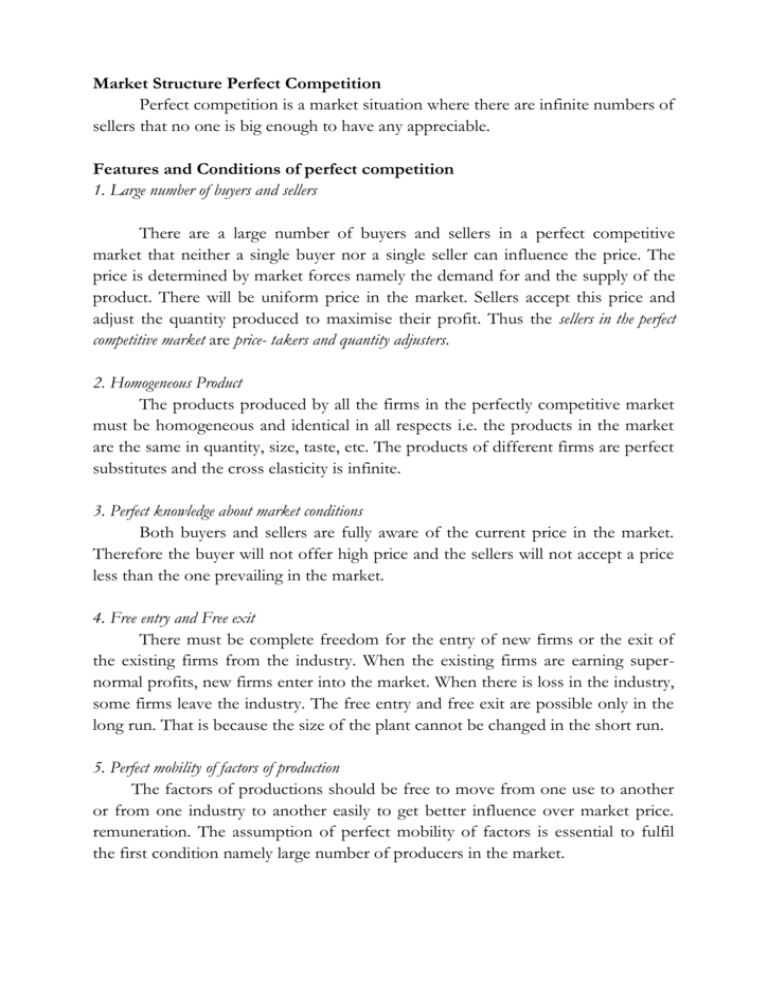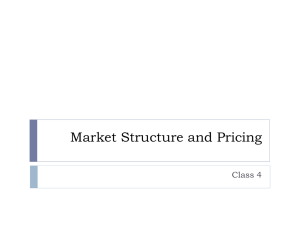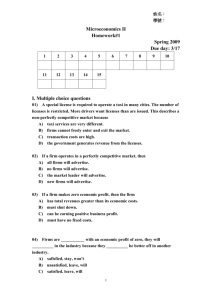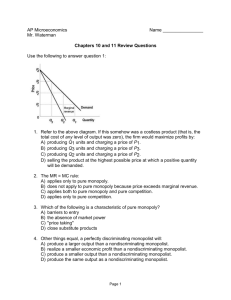Monopoly - SNS Courseware
advertisement

Market Structure Perfect Competition Perfect competition is a market situation where there are infinite numbers of sellers that no one is big enough to have any appreciable. Features and Conditions of perfect competition 1. Large number of buyers and sellers There are a large number of buyers and sellers in a perfect competitive market that neither a single buyer nor a single seller can influence the price. The price is determined by market forces namely the demand for and the supply of the product. There will be uniform price in the market. Sellers accept this price and adjust the quantity produced to maximise their profit. Thus the sellers in the perfect competitive market are price- takers and quantity adjusters. 2. Homogeneous Product The products produced by all the firms in the perfectly competitive market must be homogeneous and identical in all respects i.e. the products in the market are the same in quantity, size, taste, etc. The products of different firms are perfect substitutes and the cross elasticity is infinite. 3. Perfect knowledge about market conditions Both buyers and sellers are fully aware of the current price in the market. Therefore the buyer will not offer high price and the sellers will not accept a price less than the one prevailing in the market. 4. Free entry and Free exit There must be complete freedom for the entry of new firms or the exit of the existing firms from the industry. When the existing firms are earning supernormal profits, new firms enter into the market. When there is loss in the industry, some firms leave the industry. The free entry and free exit are possible only in the long run. That is because the size of the plant cannot be changed in the short run. 5. Perfect mobility of factors of production The factors of productions should be free to move from one use to another or from one industry to another easily to get better influence over market price. remuneration. The assumption of perfect mobility of factors is essential to fulfil the first condition namely large number of producers in the market. 6. Absence of transport cost In a perfectly competitive market, it is assumed that there are no transport costs. Under perfect competition, a commodity is sold at uniform price throughout the market. If transport cost is incurred, the firms nearer to the market will charge a low price than the firms far away. Hence it is assumed that there is no transport cost. 7. Absence of Government or artificial restrictions or collusions There are no government controls or restrictions on supply, pricing etc. There is also no collusion among buyers or sellers. The price in the perfectly competitive market is free to change in response to changes in demand and supply conditions. Nature of Revenue curves Under perfect competition, the market price is determined by the market forces namely the demand for and the supply of the products. Hence there is uniform price in the market and all the units of the output are sold at the same price. As a result the average revenue is perfectly elastic. The average revenue curve is horizontally parallel to X-axis. Since the Average Revenue is constant, Marginal Revenue is also constant and coincides with Average Revenue. AR curve of a firm represents the demand curve for the product produced by that firm. Short run equilibrium price and output determination under perfect competition 1. Since a firm in the perfectly competitive market is a price-taker, it has to adjust its level of output to maximise its profit. The aim of any producer is to maximise his profit. 2. The short run is a period in which the number and plant size of the firms are fixed. In this period, the firm can produce more only by increasing the variable inputs. 3. As the entry of new firms or exit of the existing firms are not possible in the short-run, the firm in the perfectly competitive market can either earn super-normal profit or normal profit or incur loss in the short period. Super-normal Profit When the average revenue of the firm is greater than its average cost, the firm is earning super-normal profit. Short-run equilibrium with super-normal profits In figure 8.1, output is measured along the x-axis and price, revenue and cost along the y-axis. OP is the prevailing price in the market. PL is the demand curve or average and the marginal revenue curve. SAC and SMC are the short run average and marginal cost curves. The firm is in equilibrium at point „E‟ where MR = MC and MC curve cuts MR curve from below at the point of equilibrium. Therefore the firm will be producing OM level of output. At the OM level of output ME is the AR and MF is the average cost. The profit per unit of output is EF (the difference between ME and MF). The total profits earned by the firm will be equal to EF (profit per unit) multiplied by OM or HF (total output). Thus the total profits will be equal to the area HFEP. HFEP is the supernormal profits earned by the firm. Long run equilibrium, price and output determination In the long run, all factors are variable. The firms can increase their output by increasing the number and plant size of the firms. Moreover, new firms can enter the industry and the existing firms can leave the industry. As a result, all the existing firms will earn only normal profit in the long run. If the existing firms earn supernormal profit, the new firms will enter the industry to compete with the existing firms. As a result, the output produced will increase. When the total output increases, the demand for factors of production will increase leading to increase in prices of the factors. This will result in increase in average cost. On the other side, when the output produced increases, the supply of the product increases. The demand remaining the same, when the supply of the product increases, the price of the product comes down. Hence the average revenue will come down. A fall in average revenue and the rise in average cost will continue till both become equal. (AR = AC). Thus, all the perfectly competitive firms will earn normal profit in the long run. Figure 8.3 represents long run equilibrium of firm under perfect competition. The firm is in equilibrium at point S where LMC = MR = AR = LAC. The long run equilibrium output is ON. The firm is earning just the normal profit. The equilibrium price is OP. If the price rises above OP, the firm will earn abnormal profit, which will attract new firms into the industry. If the price is less than OP, there will be loss and the tendency will be to exit. So in the long run equilibrium, OP will be the price and marginal cost will be equal to average cost and average revenue. Thus the firm in the long run will earn only normal profit. Competitive firms are in equilibrium at the minimum point of LAC curve. Operating at the minimum point of LAC curve signifies that the firm is of optimum size i.e. producing output at the lowest possible average cost. Monopoly Monopoly is a market structure in which there is a single seller, there are no close substitutes for the commodity it produces and there are barriers to entry. Characteristics of Monopoly 1. Single Seller: There is only one seller; he can control either price or supply of his product. But he cannot control demand for the product, as there are many buyers. 2. No close Substitutes: There are no close substitutes for the product. The buyers have no alternatives or choice. Either they have to buy the product or go without it. 3. Price: The monopolist has control over the supply so as to increase the price. Sometimes he may adopt price discrimination. He may fix different prices for different sets of consumers. A monopolist can either fix the price or quantity of output; but he cannot do both, at the same time. 4. No Entry: There is no freedom to other producers to enter the market as the monopolist is enjoying monopoly power. There are strong barriers for new firms to enter. There are legal, technological, economic and natural obstacles, which may block the entry of new producers. 5. Firm and Industry: Under monopoly, there is no difference between a firm and an industry. As there is only one firm, that single firm constitutes the whole industry. . Causes for Monopoly 1. Natural: A monopoly may arise on account of some natural causes. Some minerals are available only in certain regions. For example, South Africa has the monopoly of diamonds; nickel in the world is mostly available in Canada and oil in Middle East. This is natural monopoly. 2. Technical: Monopoly power may be enjoyed due to technical reasons. A firm may have control over raw materials, technical knowledge, special know-how, scientific secrets and formula that enable a monopolist to produce a commodity. e.g., Coco Cola. 3. Legal: Monopoly power is achieved through patent rights, copyright and trade marks by the producers. This is called legal monopoly. 4. Large Amount of Capital: The manufacture of some goods requires a large amount of capital or lumpiness of capital. All firms cannot enter the field because they cannot afford to invest such a large amount of capital. This may give rise to monopoly. For example, iron and steel industry, railways, etc. 5. State: Government will have the sole right of producing and selling some goods. They are State monopolies. For example, we have public utilities like electricity and railways. These public utilities are undertaken by the State. Price and Output Determination A monopolist like a perfectly competitive firm tries to maximise his profits. A monopoly firm faces a downward sloping demand curve, that is, its average revenue curve. The downward sloping demand curve implies that larger output can be sold only by reducing the price. Its marginal revenue curve will be below the average revenue curve. The average cost curve is „U‟ shaped. The monopolist will be in equilibrium when MC = MR and the MC curve cuts the MR curve from below. In figure 8.4, AR is the Average Revenue Curve and MR is the Marginal revenue curve. AR curve is falling and MR curve lies below AR. The monopolist is in equilibrium at E where MR = MC. He produces OM units of output and fixes price at OP. At OM output, the average revenue is MS and average cost MT. Therefore the profit per unit is MS-MT = TS. Total profit is average profit (TS) multiplied by output (OM), which is equal to HTSP. The monopolist is in equilibrium at point E and produces OM output at which he is earning maximum profit. The monopoly price is higher than the marginal revenue and marginal cost. Advantages 1. Monopoly firms have large-scale production possibilities and also can enjoy both internal and external economies. This will result in the reduction of costs of production. Output can be sold at low prices. This is beneficial to the consumers. 2. Monopoly firms have vast financial resources which could be used for research and development. This will enable the firms to innovate quickly. 3. There are a number of weak firms in an industry. These firms can combine together in the form of monopoly to meet competition. In such a case, market can be expanded. Although there are some advantages, there is a danger that monopoly power might be misused for exploiting the consumers. Disadvantages 1. A monopolist always charges a high price, which is higher than the competitive price. Thus a monopolist exploits the consumers. 2. A monopolist is interested in getting maximum profit. He may restrict the output and raise prices. Thus, he creates artificial scarcity for his product. 3. A monopolist often charges different prices for the same product from different consumers. He extracts maximum price according to the ability to pay of different consumers. 4. A monopolist uses large-scale production and huge resources to promote his own selfish interest. He may adopt wrong practices to establish absolute monopoly power. 5. In a country dominated by monopolies, wealth is concentrated in the hands of a few. It will lead to inequality of incomes. This is against the principle of the socialistic pattern of society. Methods of Controlling Monopoly 1. Legislative Method: Government can control monopolies by legal actions. Anti-monopoly legislation has been enacted to check the growth of monopoly. In India, the Monopolies and Restrictive Trade Practices Act was passed in 1969. The objective of this Act is to prevent the unwanted growth of private monopolies and concentration of economic power in the hands of a small number of individuals and families. 2. Controlling Price and Output: This method can be applied in the case of natural monopolies. Government would fix either price or output or both. 3. Taxation: Taxation is another method by which the monopolistic power can be prevented or restricted. Government can impose a lump-sum tax on a monopoly firm, irrespective of its level of output. Consequently, its total profit will fall. 4. Nationalisation: Nationalising big companies is one of the solutions. Government may take over such monopolistic companies, which are exploiting the consumers. 5. Consumer’s Association: The growth of monopoly power can also be controlled by encouraging the formation of consumers associations to improve the bargaining power of consumers. Comparison between Perfect Competition and Monopoly The main aim of firms both under monopoly and perfect competition is to maximise profit. In both the market forms, the firms are in equilibrium at the output level where MC = MR. The differences are as follows: Price Discrimination Price discrimination means the practice of selling the same commodity at different prices to different buyers. If the monopolist charges different prices from different consumers for the same commodity, it is called price discrimination or discriminating monopoly. Definition Price discrimination may be defined as “the sale of technically similar products at prices which are not proportional to marginal cost”. For example, all cinema theatres charge different prices for different classes of people. Conditions of Price Discrimination Price discrimination is possible only if the following conditions are fulfilled. 1. The demand must not be transferable from the high priced market to the low priced market. If rich people do not buy the high-priced deluxe edition of the book, but wait for the low-priced popular edition to come out, then personal discrimination will fail. 2. The monopolist should keep the two markets or different markets separate so that the commodity will not be moving from one market to the other market. If it is possible to buy the product in the cheaper market of the monopolist and sell it in the dearer market, there can never be two prices for the commodity. If the industrial buyer of cheap electricity uses it for domestic consumption, then trade discrimination will fail. The above two conditions are essential to adopt price discrimination. Monopolistic Competition Monopolistic competition, as the name itself implies, is a blending of monopoly and competition. Monopolistic competition refers to the market situation in which a large number of sellers produce goods which are close substitutes of one another. The products are similar but not identical. The particular brand of product will have a group of loyal consumers. In this respect, each firm will have some monopoly and at the same time the firm has to compete in the market with the other firms as they produce a fair substitute. The essential features of monopolistic competition are product differentiation and existence of many sellers. The following are the examples of monopolistic competition in Indian context. 1. Shampoo - Sun Silk, Clinic Plus, Ponds, Chik, Velvette, Kadal, Head and Shoulder, Pantene, Vatika, Garnier, Meera 2. Tooth Paste - Binaca, Colgate, Forhans, Close-up, Promise, Pepsodent, Vicco Vajradanti, Ajanta, Anchor, Babool. Characteristics of Monopolistic Competition (i) Existence of Large Number of firms: Under monopolistic competition, the number of firms producing a commodity will be very large. The term „very large‟ denotes that contribution of each firm towards the total demand of the product is small. Each firm will act independently on the basis of product differentiation and each firm determines its price-output policies. Any action of the individual firm in increasing or decreasing the output will have little or no effect on other firms. (ii) Product differentiation: Product differentiation is the essence of monopolistic competition. Product differentiation is the process of altering goods that serve the same purpose so that they differ in minor ways. Product differentiation can be brought about in various ways. Product differentiation is attempted through (a) physical difference; (b) quality difference; (c) imaginary difference and (d) purchase benefit difference. It may be by using different quality of the raw material and different chemicals and mixtures used in the product. Difference in workmanship, durability and strength will also make product differentiation. Product differentiation may also be effected by offering customers some benefits with the sale of the product. Facilities like free servicing, home delivery, acceptance of returned goods, etc. Would make the customers demand that particular brand of product when such facilities are available. Product differentiation through effective advertisement is another method. This is known as sales promotion. By frequently advertising the brand of the product through press, film, radio, and TV, the consumers are made to feel that the brand produced by the firm in question is superior to that of other brands sold by other firms. (iii) Selling Costs: From the discussion of „product differentiation‟, we can infer that the producer under monopolistic competition has to incur expenses to popularise his brand. This expenditure involved in selling the product is called selling cost. According to Prof. Chamberlin, selling cost is “the cost incurred in order to alter the position or shape of the demand curve for a product”. Most important form of selling cost is advertisement. Sales promotion by advertisement is called non-price competition. (iv) Freedom of entry and exit of firms: Another important feature is the freedom of any firm to enter into the field and produce the commodity under its own brand name and any firm can go out of the field if so chosen. There are no barriers as in the case of monopoly Monopolistic competition presupposes that customers have definite preferences for particular varieties or brand of products. Hence pricing is not the problem but product differentiation is the problem and competition is not on prices but on products. Thus in monopolistic competition, the features of monopoly and perfect competition are partially present. Determination of Equilibrium price and output under monopolistic competition The monopolistic competitive firm will come to equilibrium on the principle of equalising MR with MC. Each firm will choose that price and output where it will be maximising its profit. Figure 8.5 shows the equilibrium of the individual firm in the short period. Short Period Equilibrium of a Monopolistic competitive firm with Profit MC and AC are the short period marginal cost and average cost curves. The sloping down average revenue and marginal revenue curves are shown as AR and MR.. The equilibrium point is E where MR = MC. The equilibrium output is OM and the price of the product is fixed at OP. The difference between average cost and average revenue is SQ. The output is OM. So, the supernormal profit for the firm is shown by the rectangle PQSR. The firm by producing OM units of its commodity and selling it at a price of OP per unit realizes the maximum profit in the short run. The different firms in monopolistic competition may be making either abnormal profits or losses in the short period depending on their costs and revenue curves.









